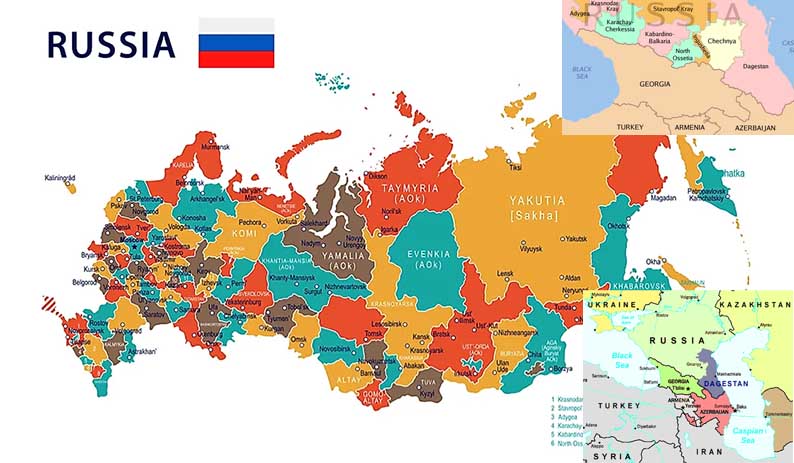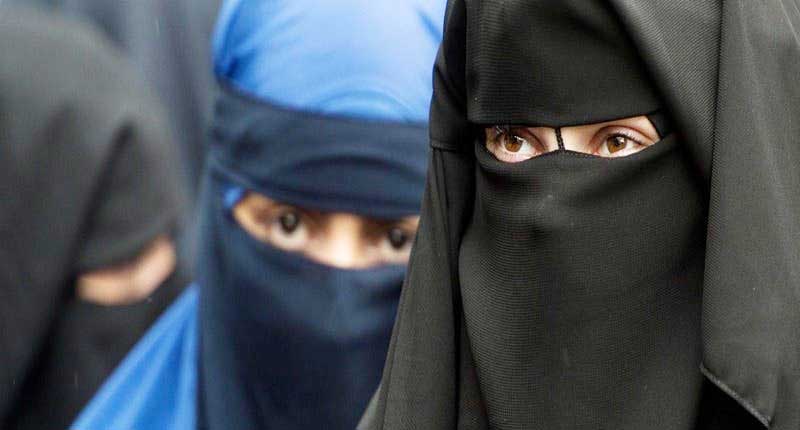
Corporate media may speak truth to power on matters not crucial to the latter. (Indeed, market forces may demand it.) But all corporate media are obliged to speak power to truth on matters which are. Such as demonising Russia for reasons set out often on this site.
One consequence of the media-inculcated ignorance afflicting most Westerners, intellectuals included, on Russia is that the place is viewed as a cross between banana republic, “gas station with nukes” and kleptocracy; the personal fiefdom of a Satanic leader, one Vladimir Putin.
One aspect of that being the rarity of Westerners who grasp – since the complexity of so vast an entity is at odds with so one-dimensional a picture – that Russia is a federation, its Regions enjoying levels of autonomy akin to those of Florida or Queensland.
(Though in truth this does not do justice to the Russian Federation’s far greater levels of ethnic diversity than those of a genocidally cleansed USA or Australia.)
Two such Regions being Dagestan and Karachay-Cherkessia. Before going into why I single out these two, let me sketch out a little context.
The Chechen Wars of the ’90s saw valid grievances against Moscow fomented and armed, in ways foreshadowing those of the dirty war on Syria, by Washington along lines suggested in a now infamous Rand Report of 2019 featured in my posts on the failed US coup in Kazakhstan.
These wars were settled – one fruit being the performance of Chechen Brigades in Ukraine – through greater autonomy for, and respect for difference in, Chechnya. Take homosexuality. According to this account it is not flat out illegal but, unlike other Regions, Chechnya offers no protections. LGBTs may lawfully be excluded from employment and housing, while “honour killings” take place with impunity. Indeed, police may join in.
Both Central Asia and South Caucasus are of high strategic significance. They are perceived as weak points by a US still aiming to Balkanise the RF into feuding statelets whose vast natural wealth can be easily extracted as per the normal divide-and-rule imperial playbook. This too is set out in the 2019 Rand Report.
Moreover, the geostrategic significance of Central Asia and South Caucasus has only risen in the wake of US defeat in Afghanistan, and as China’s BRI builds road and rail corridors in Eurasia to bypass sea lanes which may be closed off by US naval power.
Last but not least is a demographic truth noted in a footnote to my June 14 post on Russia now being the world’s fourth largest economy:
At 144 million, Russia has a lower population than China’s 1.43bn, America’s 342 million or India’s 1.44bn. This makes her economic status – less dependent on energy exports (10-15% of PPP-adjusted GDP) than Western media and [that ‘gas station with nukes’ insult] would have us believe – all the more impressive. But it points too to a looming problem others – John Mearsheimer, Alexander Mercouris and crucially Vladimir Putin in his State of the Nation address a fortnight before his landslide re-election in March – have noted. In [a video featured in the post in question] Alexander [Mercouris] sets out three options open to Russia. The easiest is to step up automation, in a country hardly short of investment funds. A second is to incentivise larger families, but that’s a twenty-five year project and has natural limits. A third is immigration. The first two are underway but the third is, in any country, politically sensitive. Which is no doubt why the Kremlin seldom mentions it. Nevertheless, an obvious labour pool lies in Central Asia, though Russia’s defiance of the West has won it new admirers in the global south at large.
Context duly sketched out, let me hand over to Andrew Korybko, writing today on why those Muslim Regions, Dagestan and Karachay-Cherkessia, have done what Moscow did not dare, and banned, albeit temporarily, the niqab.

Russia’s Majority-Muslim Regions Are Paving The Way By Temporarily Banning The Niqab
It’s ironic that Russia’s majority-Orthodox Cabinet considers a full ban to be an unconstitutional violation of its citizens’ freedom of religion while at least two of its majority-Muslim regions thus far consider a temporary one to be a prudent security-related measure.
Russia’s majority-Muslim regions of Dagestan and Karachay-Cherkessia temporarily banned the niqab on security-related pretexts in the aftermath of last month’s terrorist attacks in Dagestan. The temporary nature of this restriction is meant to avoid violating federal law after a government document from the Cabinet seen by Kommersant in late May described a full ban as unconstitutional. That came in response to the head of the Human Rights Council calling for this shortly after late March’s Crocus terrorist attack.
It’s ironic that Russia’s majority-Orthodox Cabinet considers a full ban to be an unconstitutional violation of its citizens’ freedom of religion while at least two of its majority-Muslim regions thus far consider a temporary one to be a prudent security-related measure. This disconnect is likely due to the first’s fear of offending Russia’s growing Muslim minority, which the Grand Mufti predicted in 2019 will constitute around one-third of the population in the next 15 years, and the second’s on-the-ground reality.
The Cabinet might be acting nobly, and there’s no doubt that there’s a sizeable segment of this minority that would object to banning the niqab, but those Muslims on the front line of Russia’s domestic War on Terror in the North Caucasus understand the pragmatism behind temporary measures. At the very least, the niqab can be worn by male terrorists to disguise themselves in order to move freely among society while smuggling explosives and/or weapons, thus making this garment a security risk.
There’s also the fact that the Central Asian Republics from which the vast majority of Russia’s migrant population originates have banned the niqab to varying degrees for similar security-related reasons as well as concerns that this foreign (Arab) tradition contributes to radicalizing members of society. By letting their citizens wear it during their stay in Russia, the federal government is inadvertently undermining their policies, which in turn risks destabilizing those countries once those citizens return.
Putin & The Patriarch Reminded Russians Ethno-Religious Hate Speech is unacceptable as part of their national unity efforts after the Crocus terrorist attack, but publicly discussing the socio-security benefits of banning the niqab doesn’t constitute such. It’s only controversial if someone associates terrorism with Islam like the Head of the Russian Investigative Committee Alexander Bastrykin recently did while lobbying for this policy and accidentally upset Chechen leader Ramzan Kadyrov as a result.
The latter’s region already informally banned the niqab long ago, with this being the case beyond any doubt after a group of women were scolded on local TV in late 2020 for wearing this garment in public and then forced to remove it. Chechnya, much more than any other region in Russia, understands the socio-security risks of applying a laissez-faire approach towards foreign religious traditions even if this is for well-intentioned reasons related to upholding citizens’ human rights and whatnot.
While the federal government might remain fearful of reversing its position on the alleged unconstitutionality of officially banning the niqab, Russia’s majority-Muslim regions of Chechnya, Dagestan, and Karachay-Cherkessia are paving the way through their informal and temporary bans. More regions could foreseeably follow their lead and couldn’t be accused of ethno-religious hate speech since it’s Russian Muslims themselves that are pioneering this pragmatic solution to such a sensitive issue.
* * *
